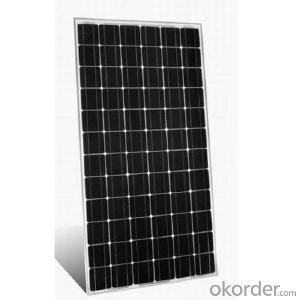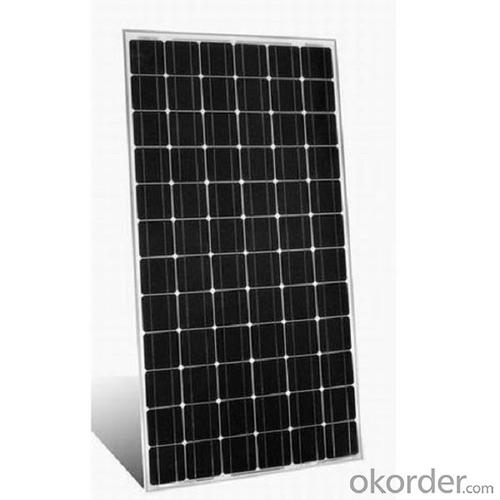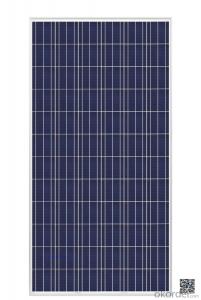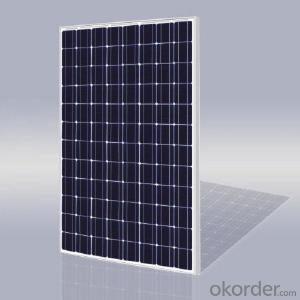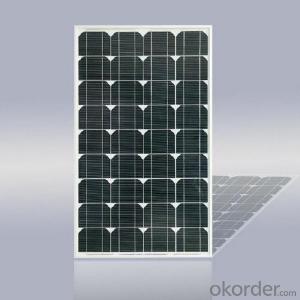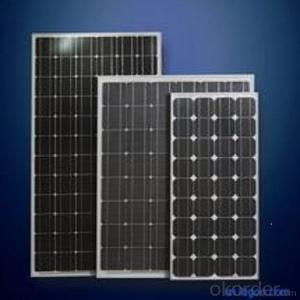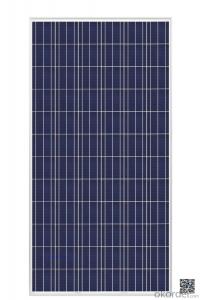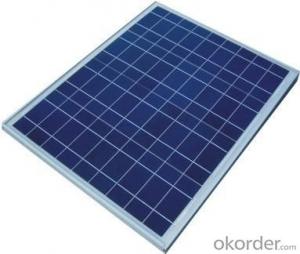Solar Panels in Hawaii - High Quality Solar Panel & Module Solutions
- Loading Port:
- Shanghai
- Payment Terms:
- TT OR LC
- Min Order Qty:
- 2500 watt
- Supply Capability:
- 26000 watt/month
OKorder Service Pledge
OKorder Financial Service
You Might Also Like
Specification
Product Description:
1.Structure of Solar Module Description
Solar panel refers either to a solar hot water panel, a common type of a solar thermal collector, or to one or more solar photovoltaics (PV) modules, electrically connected and mounted on a supporting structure.
A PV module is a packaged, connected assembly of typically 6×10 solar cells. Solar PV panels constitute the solar array of a photovoltaic systemthat generates and supplies solar electricity in commercial and residential applications. Each module is rated by its DC output power under standard test conditions, and typically ranges from 100 to 320 watts. The efficiency of a module determines the area of a module given the same rated output – an 8% efficient 230 watt module will have twice the area of a 16% efficient 230 watt module. There are a few solar panels available that are exceeding 19% efficiency. A single solar module can produce only a limited amount of power; most installations contain multiple modules. A photovoltaic system typically includes a panel or an array of solar modules, an inverter, and sometimes a battery and/or solar tracker and interconnection wiring.
2.Main Features of the Solar Module
1).High conversion efficiencies resulting in superior power output performance.
2).Outstanding power output even in low light or high temperature conditions
3).Optimized design for ease of soldering and lamination
4).Long-term stability,reliability and performance
Specification of Solar Polycrystalline(270W-290W)
CNBM Solar photovoltaic (PV)module is designed for large electrical power requirements. It is the optimal choice for both on-grid and off-grid power systems. CNBM Solar panel offers high performance of power per square foot of solar array.Poly- or multicrystalline silicon(poly-Si or mc-Si): made from cast square ingots — large blocks of molten silicon carefully cooled and solidified. Poly-Si cells are less expensive to produce than single crystal silicon cells, but are less efficient. US DOE data shows that there were a higher number of multicrystalline sales than monocrystalline silicon sales.
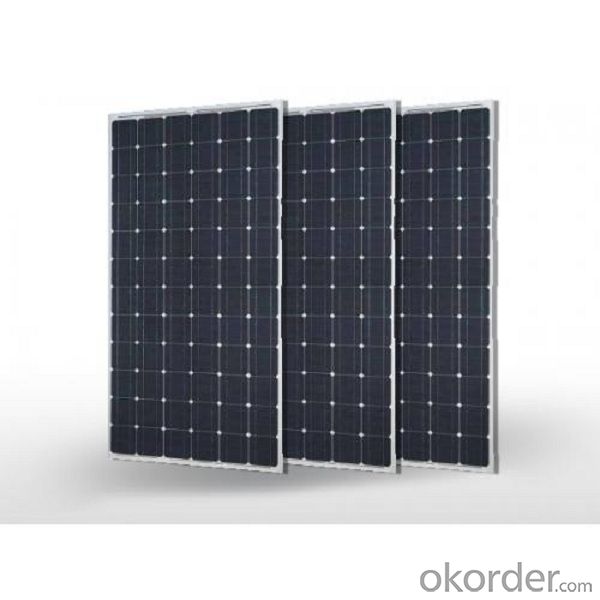
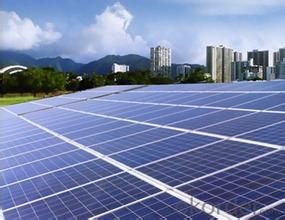
3.Characteristics of Polycrystalline Silicon Solar Panel
I.Solar Cell : High efficiency crystalline solar cell. Even if under the weak light, the solar module can produce maximum power output.
II.Tempered glass (toughened glass): Anti-reflecting coating and high transmission rate glass increase the power output and mechanical strength of solar module.
III.EVA and TPT: Using high quality EVA and TPT to prevent destroying and water.
IV.AI frame: Without screw, corner connection. 6 holes on the frame can be installed easily.
V.Junction box: Multi function junction box with water proof.
VI.Long lifetime: ≥25 years; Less power decrease.
VII.Good performance of preventing from atrocious weather such as wind and hails.
VIII.Resisting moisture and etching effectively, not effected by geology.
IX.The certificate issued by international authority: UL, TUV, IEC, VDE, CE.
4、INSTALLATION SAFETY
1. Always wear protective head gear, insulating gloves and safety shoes (with rubber soles).
2. Keep the PV module packed in the carton until installation.
3. Do not touch the PV module unnecessarily during installation. The glass surface and the frames get hot. There is a risk of burn, or you may collapse because of electric shock.
4. Do not work under rain, snow or windy conditions.
5. Use insulated tools
6. Do not use wet tools
7. Do not drop tools or hard objects on PV modules
8. When installing PV modules far above ground, do not drop any object(e.g. PV module or tools).
9. Make sure flammable gases are not generated near the installation site.
10. Completely cover the PV module surface with an opaque material during PV module installation and wiring.
11. Plug in the connector tight and ensure the wiring work.
12. Due to the risk of electrical shock, do not perform any work if the terminals of PV module are wet.
13. Do not touch the terminal box and the end of output cable ends ( connectors) with bare hands during installation or under sunlight, regardless of whether the PV module is connected to or disconnected from the system.
14. Do not unplug the connector if the system circuit is connected to a load.
15. Do not stamp on the glass at work. There is a risk of injury or electric shock if glass is broken.
16. Do not work alone (always work as a team of 2 or more people).
17. Wear a safety belt if working far above the ground.
18. Do not wear metallic jewelry which can cause electric shock during installation.
19. Do not damage the surrounding PV modules or mounting structure when replacing a PV module.
20. Bind cables by the insulation locks. Drooping down of cables from the terminal box could possibly cause various problems such as animal biting electricity leakage in puddle.
- Q: what is a solar panel?
- a electronic collection grid that turns solar energy into electric power
- Q: Online stores selling solar photo-voltaic generation kits gives specs indicating the power generation capability of the system. For example, Solar World Grid-Tie Solar Electric System with 245W Panels PV Powered PVP2000 Inverter, .2 to 2.4 kW. This seems to indicate that the system can generate .2 to 2.4 kW. Is that per day? Per month? I'm trying to calculate the return on investment, but can't because I don't know how much power a system such as this will generate in a month.
- The $25,520 price amounts to about $8.5 a watt which is high, I would've expected between $2.50 to $5 a watt and those are dated prices so it sound like the vendor is raking the price up. You didn't mention how many months your $75 financing is for but keep in mind that at 3 kw for 8 hours a day for 30 days at 2 cents per kwh, you would generate $86.40 so you will be paying about twice as much for your solar power as you would had you bought the power from the grid. Mind you, for people on a fixed income, there is the security that the cost will not rise ( if properly insured ) so there could be an advantage to paying a premium for your power if you're on a fixed income. I'd say it's a rip off but I also believe solar has a ways to go even with subsidies before it's an economic choice and that's usually not a popular stance with the green washed crowds.
- Q: what kind of rays are used in solar panels?
- Electromagnetic...meaning light rays, primarily in the visible spectrum. Ultraviolet and infrared light rays actually degrade most types of solar panels, limiting their useful lifetime. That said, your question is not stated well...so I'm not sure if that's the information you were looking for. Rays are not used in solar panels...rather solar panels are used to collect sunlight and convert it to energy--either directly into heat in the case of passive solar, or into electricity by the use of photovoltaic cells.
- Q: Can solar panels be used to power outdoor lighting?
- Yes, solar panels can be used to power outdoor lighting. Solar panels convert sunlight into electricity, which can be stored in batteries or used directly to power outdoor lights such as garden lights, pathway lights, or streetlights. This allows for environmentally friendly and cost-effective lighting solutions in outdoor areas.
- Q: Can solar panels be installed on any type of roof?
- Solar panels can be installed on most types of roofs, including flat, sloped, and angular roofs. However, some factors like the roof's orientation, shading, and structural integrity may affect the efficiency and feasibility of installation.
- Q: What is the cost of installing solar panels?
- The cost of installing solar panels can vary depending on several factors such as the size of the system, location, type of panels, and any additional equipment or services required. On average, the cost can range from $15,000 to $25,000 for a residential installation. However, it is important to consult with solar installation companies to get accurate quotes tailored to your specific needs.
- Q: For example, If I were powering my house with solar panels, would it be more efficient or effective, (or I guess would I get more energy) out of a day that measured 90 degrees Fahrenheit as opposed to a day that is 70 degrees Fahrenheit.
- Not at all. You`ll generate more energy on a clear sunny day in the winter time than you would on a cloudy day in the summer.
- Q: How do solar panels affect the property's overall sustainability?
- Solar panels can greatly enhance a property's overall sustainability by generating clean and renewable energy from the sun. By reducing reliance on fossil fuels and lowering carbon emissions, solar panels contribute to a greener environment. Additionally, solar energy can help reduce electricity bills and provide a reliable and independent source of power, making the property more self-sufficient and resilient.
- Q: Can solar panels be installed on a school or university campus?
- Yes, solar panels can be installed on a school or university campus. Many educational institutions are recognizing the benefits of solar energy and are choosing to install solar panels on their campuses. This not only helps in reducing carbon emissions and dependence on fossil fuels but also serves as an educational tool for students to learn about renewable energy. Additionally, installing solar panels can lead to cost savings on electricity bills for the institution in the long run.
- Q: Are solar panels expensive?
- Solar panels can be expensive initially, but they are a long-term investment that can significantly reduce energy costs and provide a return on investment over time.
Send your message to us
Solar Panels in Hawaii - High Quality Solar Panel & Module Solutions
- Loading Port:
- Shanghai
- Payment Terms:
- TT OR LC
- Min Order Qty:
- 2500 watt
- Supply Capability:
- 26000 watt/month
OKorder Service Pledge
OKorder Financial Service
Similar products
Hot products
Hot Searches
Related keywords
